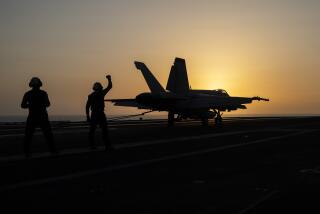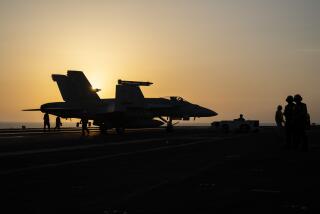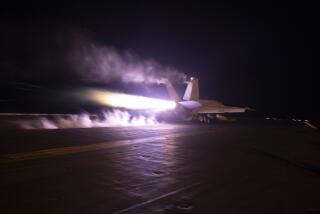Iranians Laying Anti-Ship Mines in Persian Gulf
- Share via
WASHINGTON — Iran has begun laying anti-ship mines in the northern Persian Gulf, and the United States is assessing the potential threat to U.S. Navy ships and Kuwaiti tankers sailing under American flags, a senior Administration official said Wednesday.
The official said marine salvaging sources reported that the mines have been laid in waters leading into Kuwait’s main oil port at Al Ahmadi.
At first, they were thought to have broken loose from the Shatt al Arab waterway marking the Iran-Iraq border, but “it now looks as if these may be mines that have been deliberately planted out there,” the official said. “This is a new development. It’s not clear how much of a threat it’s going to be.”
The possible use of mines--allowing Iran to sabotage Kuwait-bound ships but avoid a direct military confrontation with the United States--appears to be a contingency the Administration has yet to fully consider. At least one Soviet tanker, leased to Kuwait earlier this year, hit a mine in mid-May just outside Kuwaiti waters.
The Defense Department is planning to add more warships to the six-vessel U.S. Middle East force under its plan to provide a military escort for 11 Kuwaiti ships that are being re-registered under the American flag.
Pentagon spokesman Robert B. Sims said Tuesday that there are no plans to add minesweepers to the fleet. He said the Defense Department is still evaluating the potential threat of the mines.
Other Possibilities
Sims said there are “other ways” to deal with the threat than sending U.S. minesweepers. One U.S. official noted that Saudi Arabia has four U.S.-built minesweepers in its small navy.
The Soviet Union, which has leased three oil tankers to Kuwait, now has at least three minesweepers in the gulf or nearby and is adding one guided-missile cruiser, according to Assistant Secretary of Defense Richard L. Armitage, who testified before the Senate Foreign Relations Committee Tuesday.
The use of mines is a tricky issue because the Iranians appear to be laying them only inside Kuwaiti waters where U.S. naval ships escorting the Kuwaiti tankers are not now scheduled to enter. Thus, the Kuwaiti tankers could be successfully escorted through the gulf only to be hit later by Iranian mines.
This is not the first time the United States and its Middle East allies have contended with a mine threat. In the late summer of 1984, a Libyan ship spread mines in the Red Sea in an attempt to sabotage traffic passing through the Suez Canal.
The United States, among a number of other Western powers, sent minesweepers to destroy what turned out to be makeshift Libyan mines that did no serious damage.
More to Read
Sign up for Essential California
The most important California stories and recommendations in your inbox every morning.
You may occasionally receive promotional content from the Los Angeles Times.










